July has been a bit of a washout. But I’m not complaining because I’ve been spared hours of watering in my newly planted garden. Still, I am trying to warm myself up with some fiery colours. Last week, I was in the red and this week I have some more reds and warm oranges in pots.
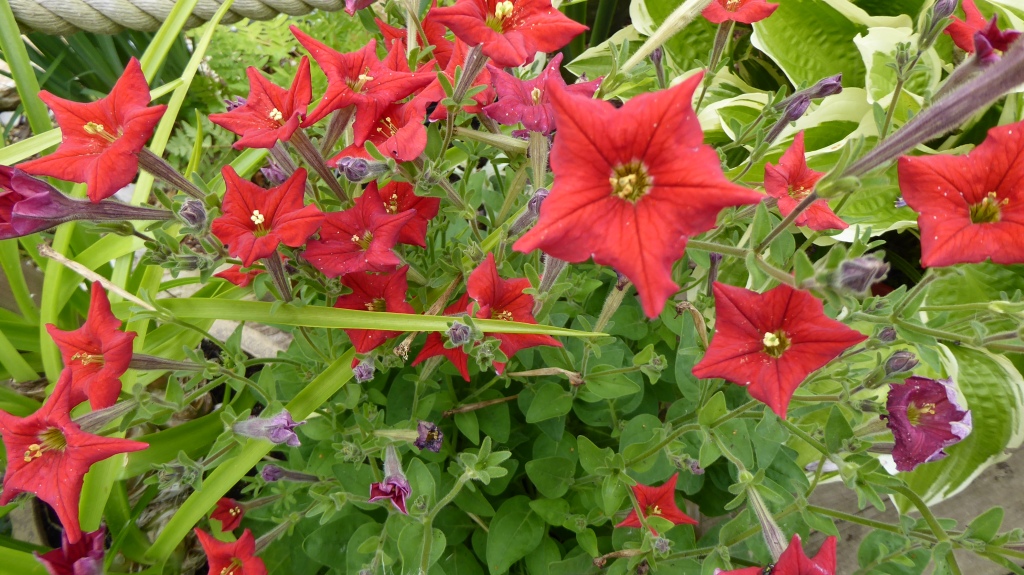
My first one is beautiful Petunia exserta which I grew for the first time several years ago and wrote about on my blog. This year I am growing it again as it is a favourite of mine and it has a story; I love a plant with a story. This species petunia is so rare in its native homeland; the ancient and isolated pampas grassland of the Serras de Sedesta in Southern Brazil that it is almost extinct, like the Dodo. In fact maybe it already is extinct in the wild and growing it just like having a Dodo in the garden. It was only discovered in 1987 and in 2007 there were only 14 true Petunia exserta plants in the wild. Of course, there are the usual pressures of loss of habitat and climate change, but the other problem for this dear little petunia is that it hybridises with the wild white Petunia axillaris which is one of the parents of our modern petunias. Actually, I have found seed companies which list Petunia axillaris and next year I think I might try it, as it is intensely fragrant and will climb if given support. Obviously I won’t grow it alongside Petunia exserta. Mayan and Inca people believed that the scent of petunias warded off dangerous underground monsters and spirits, so that is handy. Petunia exserta is not fragrant as it is pollinated by hummingbirds and that is why it is bright red, so that it will attract them in spite of being tucked away in shady nooks on rocks. The flowers are star-shaped and the name exserta means projecting or thrust out and it refers to the extended stamens and stigma. I love it. It is easy from seed, I just sow it thinly in the pots it’s going to live in, so I don’t have to bother pricking it out.
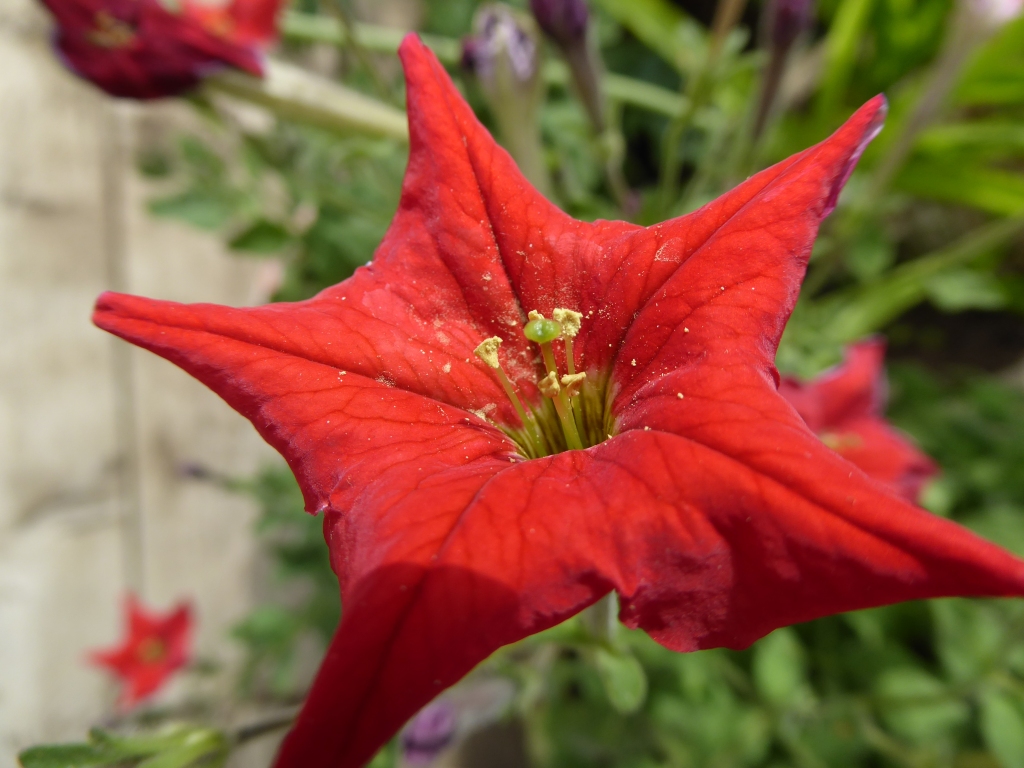
Next I have a common or garden hippeastrum which we all grow at Christmas and for some reason incorrectly call ‘Amaryllis‘. I am not sure of the name of this one; it’s possibly ‘Red Lion’, but it is such an intense red. I like the way it blooms on a short stalk; they usually have such impractical giraffe necks. I have found that when I get these bulbs to re-flower they always do it in summer.
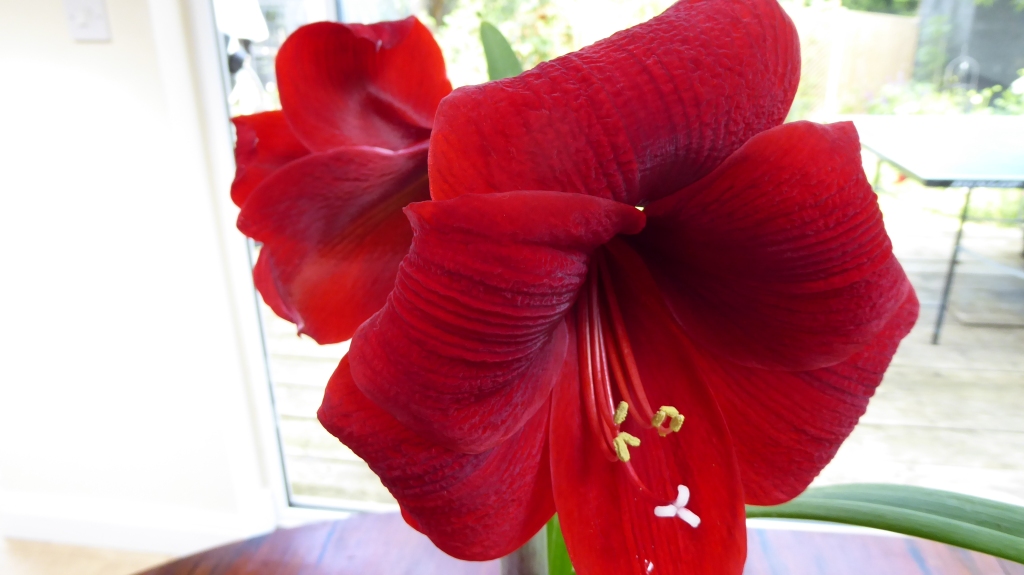
I have lots of red pelargoniums in pots which I have accumulated over the years; most of them with long forgotten names. But I always recognise Pelargonium ‘Paul Crampel’ because of its huge bright red flowers. This is a zonal pelargonium which took the world by storm when it was introduced in 1860. Nobody had ever seen such vigorous, bushy pelargoniums with such huge intensely scarlet flowers. It sold for a guinea each, which was a huge sum; about £110 in today’s money. This pelargonium became a familiar sight as it was planted outside Buckingham Palace for many years. Today, it has perhaps been superseded by ‘Moulin Rouge’ which is even better, but I like a bit of history with my plants. This is just a young plant from a cutting earlier this year but it will grow into a substantial plant.
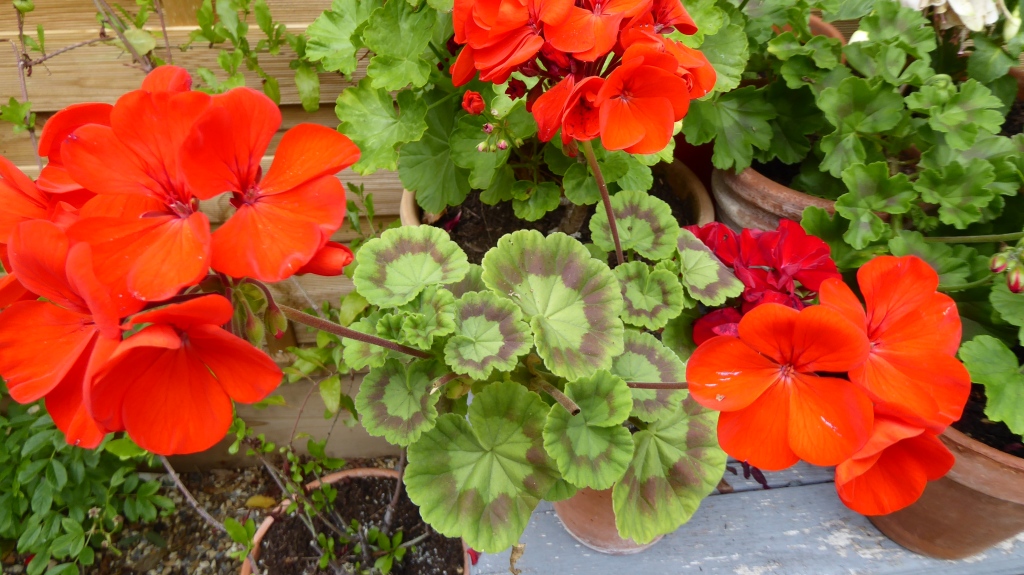
Rosebud pelargoniums also create a bit of nostalgia, especially Pelargonium ‘Apple Blossom Rosebud’ which appeared in 1870 and was a favourite of Queen Victoria.
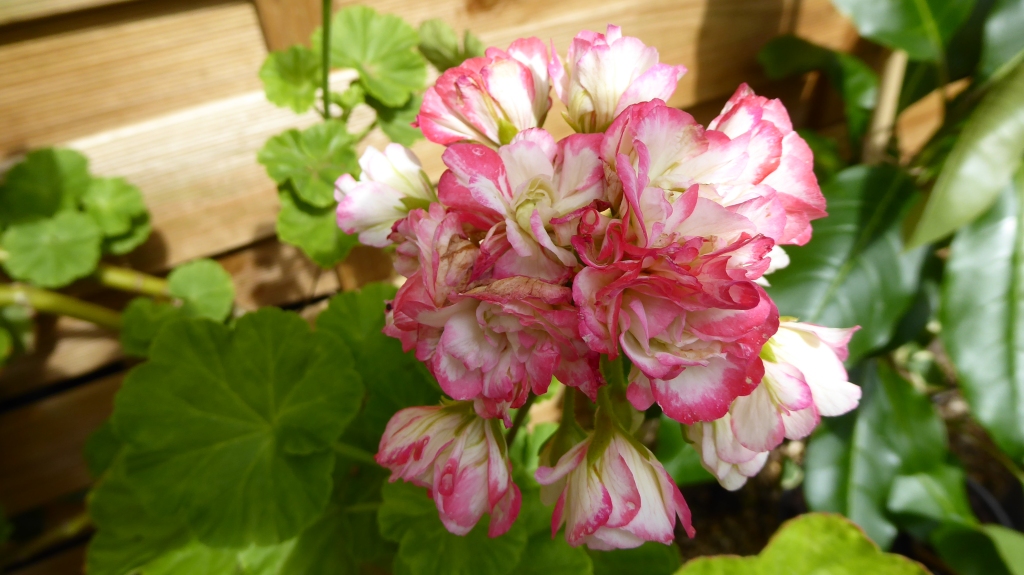
The Rosebud pelargonium was not created by some sort of Frankenstein genetic manipulation, it appeared as a spontaneous mutation in 1850. As you can imagine it was popular for buttonholes with its tight heads of double flowers. I also have Pelargonium ‘Scarlet Rambler’ which is a rosebud pelargonium from 1870. Both these rosebuds grow to about 60 cm. ‘ Apple Blossom Rosebud” kept on growing and bloomed all winter in the conservatory. ‘I chopped ‘Scarlet Rambler’ down and kept it in the shed, so I am lucky it survived. This winter it will come into the conservatory. I don’t know why it’s called ‘Rambler’ because it is an upright one and doesn’t ramble with me.
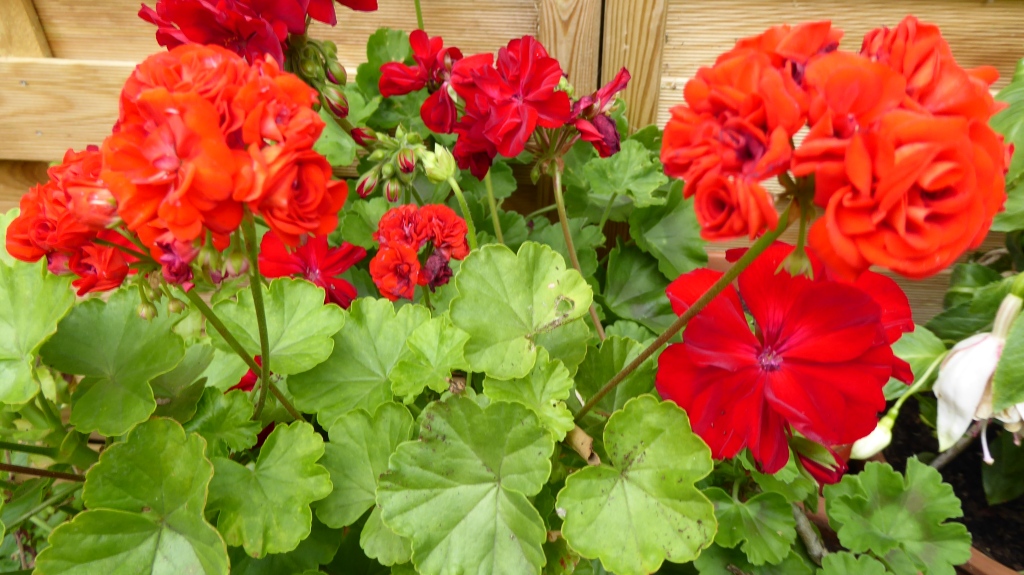
Mimulus auranticus has lovely orange, tubular flowers. I find it has confusingly been renamed Diplacus auranticus which I might have trouble remembering. But still, I refuse to call it Sticky Monkey Flower, even though it is sticky. This lovely plant is smothered in flowers throughout the summer. It comes from California where it is pollinated by two sorts of flies which have extremely long tongues which can reach down its long tubular throat. I don’t know whether we have any flies with long tongues here, but I take cuttings. This plant has to be kept frost free and quite dry in winter.
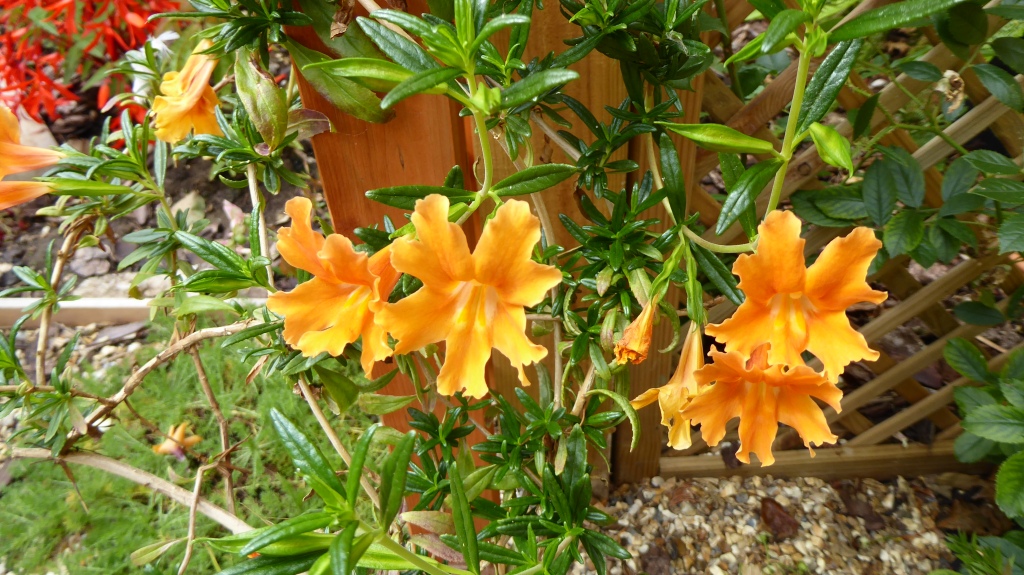
The orange flowered Thunbergia alata (or Black-Eyed Susie if you must,) flowers all summer long. I have it in a pot growing up the trellis in my secret garden. I wish I had planted it in the ground now, as it grows huge. It is usually treated as an annual but I put it in a pot because it can be perennial if it’s kept frost free. This is a fast growing climber which is easy from seed. You can get it in the more traditional yellow with a black eye or white or even pink. I love this orange one because it really glows.
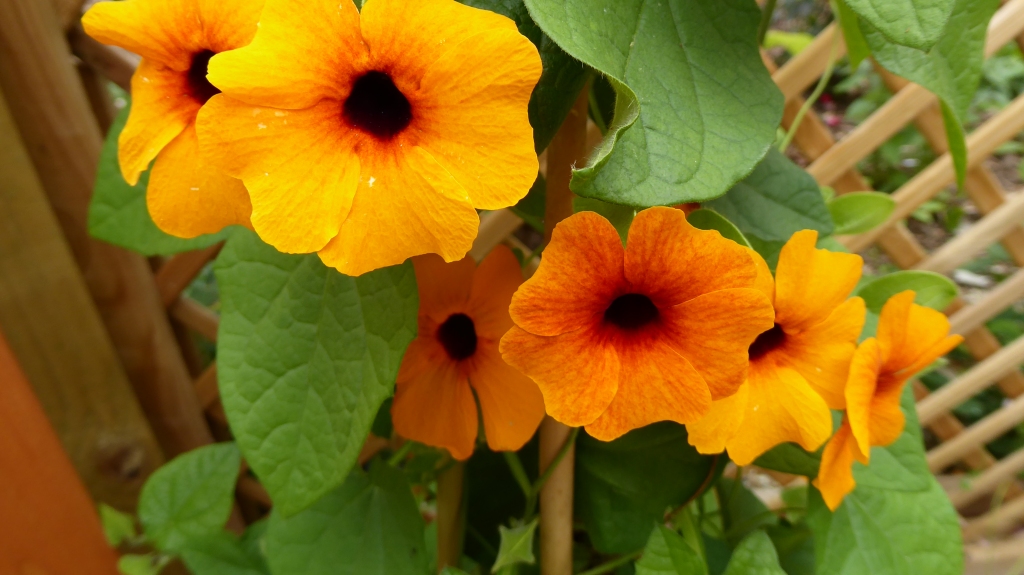
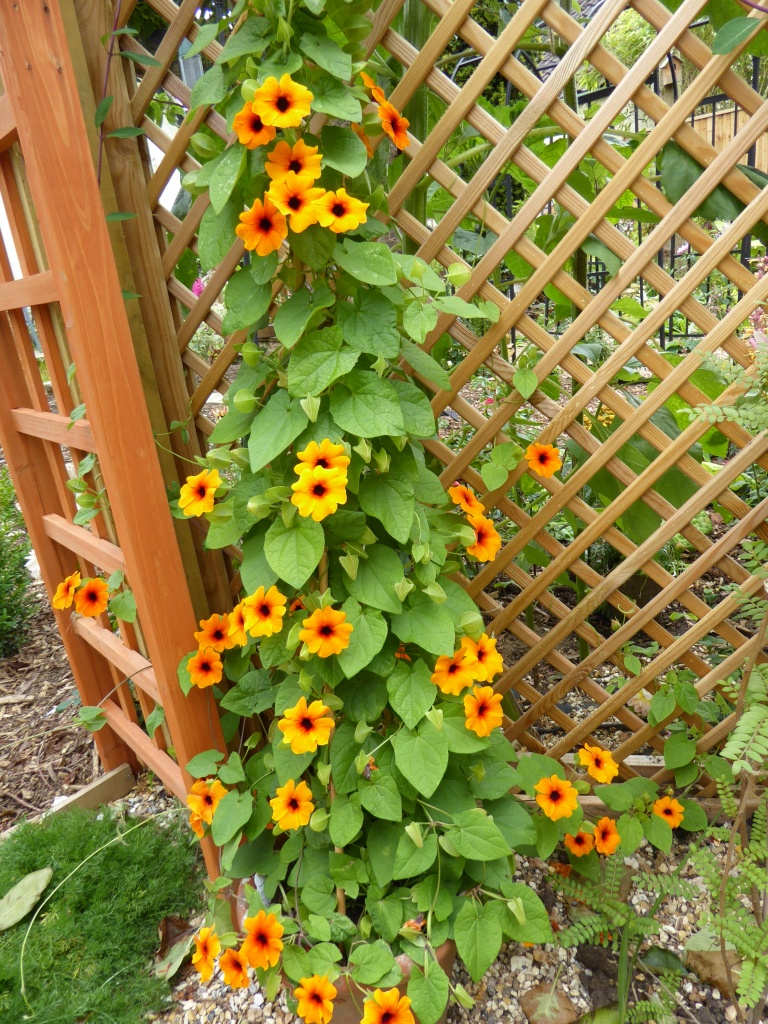
Oh dear, that seems to be seven plants, but I only included Pelargonium ‘Rosebud Apple Blossom’ to show you Queen Victoria’s favourite, so let’s not count it.
As usual Six on Saturday is hosted by Jim at Garden Ruminations who always has interesting plants to show us. And of course, here you’ll find links to keen gardeners round the world who share their seasonal beauties.

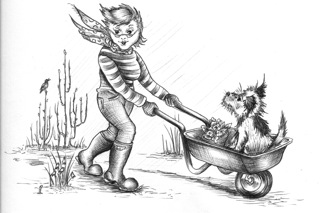
A very impressive ‘seven’ with all you added history for them I really like the Thunbergia alata.
Seven maybe, but we’re not counting Pelargonium ‘Apple Blossom Rosebud’. Forget you saw it. Yes, the orange Thunbergia alata is gorgeous.
The Petunia exserta has a very interesting history. It’s nice to see you are keeping it going.
Yes, the petunia’s history makes it special. The fact that nobody knew about it until just 36 years ago is amazing. Thank goodness, it was found just in time to rescue it.
What marvelous botanical history you have shared with us! I will always think of it as I smell the petunias. I now no why I have a feeling of peace as I pass by them.
All the fragrant modern petunias descend from Petunia axillaris, it sounds quite special.
That Thunbergia is indeed a real picture.
It’s a beauty, isn’t it?
Lovely flowers again. The Black-Eyed Susan in particular is a wonderful specimen! (I have to call it by its common name simply because my sister is called Susan 😉)
Thank you Cathy. While I am a stickler for the correct nomenclature, I have to admit, I always call these Black-Eyed Susies.
This post reminds me of how much I missed your posts when you went silent for a stretch. I love the backstory of the petunia and, even though I’ve never cared much for that genus, I’d consider growing it to make the hummingbirds happy. I recently posted on the hot colors in my actually hot summer garden but yours are more vivid. I’ve been trying to naturalize Hippeastrums in my garden for the past few years – I accomplished that easily in my former garden but it’s been hit and miss in this one, probably due to the drier conditions.
What a nice thing to say Kris. Even if you don’t like petunias, you might like this one. I know it is available over there because Amelia, the Shrub Queen grew it in her Florida garden a few years ago. How lovely to be able to grow hippeastrums in the garden.
Love your petunia story, well done in keeping them growing. I love your Mimulus, they grow well in my garden, but are slow growing. Great pelargoniums. 🌸🌼
Can you grow Mimulus auranticus outside in your garden? I would love to get it out of its pot and have it growing in mine.
Warm and flamboyant colours are on the menu this week!
My favourite is this pretty petunia! I didn’t know it before.
Hot colours seem right at this time of the year, pastels are for June when the light is different. The petunia is certainly worth growing.
I learn something new every time I visit your blog, many thanks! I like the colour of your Thunbergia, different from the norm, I might be tempted to have a go at growing it!
I am glad you feel you learn something from my blog Pauline.. The Pianist says I am a plant nerd; the trainspotter of the plant world. Better plants than trains, I say. Yes ,this thunbergia is a beauty.
Spicy pots! I had the P. exserta for several years after seeing yours. I am also curious about the axillaris and look forward to seeing it. I was researching flowers today and ran across two new ones to try – have you had these? Orlaya or Bupleurum? They are supposed to be winter cut flowers here.
I remember you growing Petunia exserta Amy. I would like to try P. axillaris because it us supposed to be intensely fragrant and I love white flowers. Yes, I love umbellifers and I have grown both of these. Which Bupleurum are you going to grow? I used to have Bupleurum fruticosum which is a shrub. I have aso tried Bupleurum rotundifolium and Bupleurum falcatum.
B. rotundifolium is what I can find here. I can’t recall ever noticing fragrance in a Petunia – that should be interesting. I succumbed to end of season sales and bought Dahlias and green glads…I should have some mad winter vases.
I also used to grow one called Bupleurum longifolium which had copper coloured flowers which looked a bit like tiny astrantias. Look forward to seeing your dahlias. Everyone needs dahlias.
That sounds wonderful. So far I am only seeing green flowers. I hope these Dahlias work. Dahlias in Florida have strange parameters.
A lovely selection. I’m not sure what I do wrong with Thunbergia – they never really take off for some reason. They thrive in my mother-in-law’s garden though.
Thank you. I have been feeding the Thunbergia regularly with tomato food and I think this has really made a difference.
The Pelargoniums are beautiful. And that ‘Orange Beauty’ Thunbergia…wow! It really does glow! Beautiful photos, too.
Thank you Beth. My photos are never anything like your beauties as I am no photographer. But you can see the glowing colour of the Thunbergia, it is a beauty.
Oh, your photos are amazing, Chloris! By the way, I added your name and web address to your comment on my post. Thanks for stopping by! Have a great Sunday!
I love your bits of history of the plants. Beautiful Hippeastrum. My sisters have them flowering in garden beds each summer, planted by a previous owner of their house. They overwinter and put on quite a show in summer. I’ve had sporadic luck getting them to bloom again .
Thank you Susie. I would love to grow hippeastrums in the garden, that must be a sight.
It is beautiful to see the hippeastrums. They have at least 3 dozen blooms at a time. One summer I was lucky enough to visit when they were blooming and I came home with about a dozen cut flowers. Luxurious.
Like the others I love the tales associated with certain plants. That mimulus is a beauty!
I always enjoy plants with a nice story attached. Yes, the mimulus has come into its own this summer, it was looking most unwell over winter and I thought I was going to lose it.
What a lovely collection of red and orange/yellow flowers!
Thank you, I love these hot colours in July, they light up the garden.
What a lovely informative post, I love learning about the history of plants. And no-0ne ever counts the SOS (well I don’t). Orange Beauty is deserving of its name. I must grow some more next year. I have tried a blue Ipomoea this year and it is yet to produce any flowers! The common bindweed on the other hand…
Thank you Jude. Yes, the Orange Beauty is fabulous. I think the blue Ipomoea needs plenty of sun to do well, unlike common bindweed which does well however cruelly you treat it.
Happy to see seven – especially the final image – No 7. The Thunbergia growing on your trellis is stunning. I’m trying to think of the ideal spot where I could try growing it here. Your red pelargoniums are beautiful. I lost all of mine last winter, and the replacement plants have been abysmal.
I used to grow Thunbergia alata up a tripod of bamboo canes but if you can give it a trellis it really takes off. Pelargoniums need more sun than we can provide them with this summer in the UK.
I missed your reply. Thank you! You’re right about the pelargoniums. I’ve grown them to use as a massed potted display at my front door for years and they’ve grown so well – this is the first year they’ve failed.
Your Thunbergia looks wonderful. Makes mine look so plain in comparison. I had no idea you could over-winter it, so thanks for that tip. I too love your interesting plant back stories. I wish I could remember such things!
Thank you Allison. Have you got the usual yellow Thunbergia? I have grown that in the past and it is pretty but this one is a great improvement.
Yes, exactly. It’s perfectly nice of course, but yours has such warmth.
Apple Blossom is one of my favourites. I was visiting a garden today and they had some in the conservatory. So pretty.
I haven’t taken any cuttings of ‘Apple Blossom’ so far. Maybe I can get one going for you, if you would like one.
Mimulus aurantiacus had been in full bloom for a while. It tends to bloom more uniformly after exceptionally rainy winters such as last winter. It is one of those wildflowers that makes me appreciate wildflowers in other regions more. Outside of cultivation, it gets quite shabby and greasy looking. I sometimes feel compelled to cut some of it back after bloom, to promote denser and more vigorous growth.
I’d love to see it growing wild. Is it always orange?
It is always orange in the wild. It is not a bright orange, but sort of a pastel orange, like the color of circus peanuts. Cultivars that are only rarely available from nurseries are generally richer orange, peachy pink, yellow or orangish red. Richer red and creamy white may be even more rare. It is prettier in cultivation, or on the edges of roads where it occasionally gets cut down. Otherwise, it gets scrubby and combustible, which is a good reason to dislike it around here.
Love all your bright coloured flowers, these petunias to are amazing. Lovely photos!
Thank you. These petunias are certainly worth growing.
It so lovely to having your entertaining and informative posts again, Chloris! 👍😊. The thunbergia is stunning, and is something I must try again – I agree this orange version is the most attractive
I did enjoy hearing the history of some of these plants. I loved petunia exserta and that gorgeous rosebud pelargonium.xxx